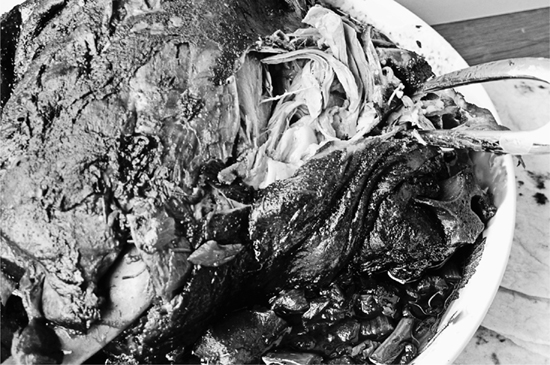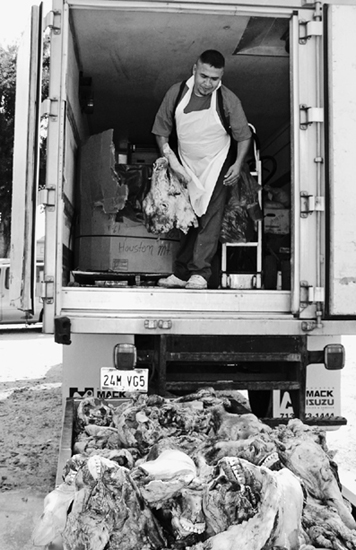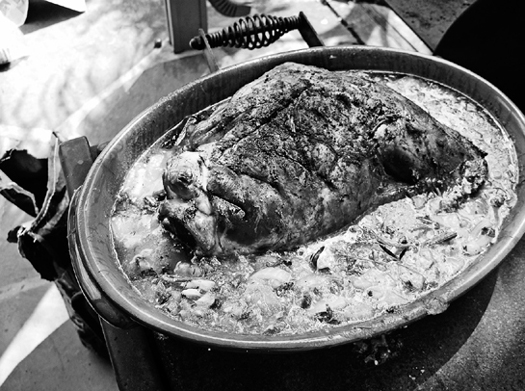
José Luis López sells the best barbacoa in Houston at Gerardo’s Drive-in Grocery, on Patton
It was quarter to eleven on Sunday morning in Houston and the sidewalks in front of Gerardo’s Drive-in Grocery on Patton were a street party. There were families carrying their food home in white paper bags and then there were the people who just couldn’t wait. • One guy had opened up a container of barbacoa meat, some salsas, and a foil package of tortillas and lined them up along the window sill under the burglar bars where he stood making tacos. A couple of women were using the newspaper machines right outside the front door as stand-up counters for their coffee cups. It was all making me hungry.
GERARDO’S, BARBACOA, VI, SA, DO, read the sign out front. Which means that barbacoa is available on Friday (Viernes), Saturday (Sábado), and Sunday (Domingo) only. Ten years ago, that was standard policy. But these days, you see barbacoa and every other variety of Mexican street food offered 24/7 at taco trucks and gas-station taquerias all over the city. So how does Gerardo’s still manage to draw such a crowd for their weekend specials, I wondered, as I shouldered my way inside. When I got up to the meat counter, my question was answered.
At other taquerias and carnicerias the “mystery meats” get a little crusty in the stainless-steel bins on the steam tables. You might have trouble finding something that looks appetizing. But at Gerardo’s you have the opposite problem: all the meats look so good, you want to eat everything. And believe me, I tried.
I loved the dark brown Texas-style barbacoa, which was made from steamed cattle cabezas. Gerardo’s steams the seasoned cow heads in giant gas-fired stainless-steel jacketed kettles that retain the broth. The gelatinous meat is satin slick on the tongue and tastes awesome with Gerardo’s tart green tomatillo and serrano salsa. On a second weekend visit, two companions and I sat down at a table with a dozen fat tamales, a pound of barbacoa de borrego, a pile of tortillas, and assorted condiments.
The barbacoa de borrego was unique. The chunks of meat were falling-apart-tender and were served with a deep red chile broth. It reminded me of the stewed goat dish called birria. Gerardo López, who was working the meat counter that day, told me that they made the barbacoa de borrego with goat meat. That was confusing, since borrego means sheep or mutton. So I asked his father, José Luis López, for an explanation. (The store is named for Gerardo López, but it’s owned by his parents, José Luis and Maria López.)
“We make the barbacoa de borrego with lamb shoulder and goat meat, mixed half and half, then seasoned with garlic, bay leaves, oregano, and chili powder,” José Luis said. The meats are cooked slowly for twelve hours in the steam kettle. Then the meat is stripped from the bone, shredded, and steeped in the broth. It’s really a cross between the Mexican goat stewed in chile broth called birria and maguey-leaf-wrapped barbacoa de borrego. The meat is absolutely fabulous—if you like that kind of thing.
Barbacoa tacos are available at Gerardo’s only on Fridays, Saturdays, and Sundays
“I can’t get over that wet dog aroma,” one of my tablemates said after trying to eat some on a taco. Some people like mutton and goat, and some don’t.
I guess I like wet dogs, because I couldn’t get enough borrego tacos, which I made on corn tortillas with the spicy meat and the pickled chile pequíns that Gerardo’s offers alongside the salsas. It’s nice to see chile pequíns as a condiment selection. They are the traditional peppers of southern Texas and northern Mexico, and the tiny round chiles still grow wild in vacant lots and along fence rows all over the city. The ones you see in stores are harvested by hand in wilderness areas in Sonora. You find them in farmer’s markets and meat markets like Gerardo’s in the autumn. And they are usually the most expensive chile peppers you can buy.
José Luis, who was born in Michoacán, opened the business as a corner grocery in 1977, so I guess he has had some time to practice. The grocery still offers a few raw vegetables and some raw meats along with the soft drinks and the chips, but mostly people come for Gerardo’s cooking.
Weekend mornings are the most fun, but Gerardo’s also serves breakfast specials and plate lunches Monday through Friday. I stopped by for lunch on a recent Monday afternoon around one o’clock and had the place pretty much to myself.
I had a plate of carne asada in a dark red sauce. In Mexico, carne asada or asado del puerco means braised pork. Gerardo’s is a slow-roasted pork shoulder in an intense sauce of garlic and dried ancho chiles, seasoned with what tastes like orange peel and bay leaves. The chile sauce is cooked down until it’s almost black—but when you spread it on a tortilla, it turns a deep brick red. The carne asada at Gerardo’s Drive-in Grocery was the best I have eaten in the United States.

This barbacoa de borrego is made from a lamb shoulder roast that’s smoke-braised until it’s falling-apart tender
THE MEANING OF BARBACOA
The English word barbecue is derived from the Spanish word barbacoa. There are lots of varieties of barbacoa in Mexico. The world’s largest Mexican restaurant, Arroyo in Mexico City, has made its style of barbacoa de borrego (barbecued lamb) famous. At the authentic Huastecan restaurant called El Hidalguense in Houston, barbacoa means lamb shoulder sealed in maguey leaves and cooked in the coals of a wood fire.
Tex-Mex barbacoa is almost always made from cabeza de la vaca, or cow head. Cow heads became the most popular meat for barbacoa in Texas because Latino ranch hands were given cow heads as part of their pay. If you ever saw the movie Giant, you might remember Elizabeth Taylor fainting when the vaqueros unwrapped the burlap bag containing the head that had been buried under the coals.
Today, the barbacoa found in Tex-Mex restaurants is usually made from seasoned cow heads that are steamed in an oven with a baño maria (bain-marie) or in a steam-jacketed kettle. There are very few old-fashioned barbacoa pits left in Texas; a restaurant called Vera’s in Brownsville is the only one I have seen. Modern health department regulations have pretty much put an end to authentic pit barbacoa.

At Tex-Mex restaurants and taquerias, cow heads are cooked in a steam-jacketed kettle like they have at Gerardo’s, or in an oven with a baño Maria (bain-marie). At home, I have made an excellent recipe using an electric roasting oven.
But steamed meat doesn’t fit the definition of barbecue for most American “Q” aficionados. And I must admit I have always wanted to cook barbacoa on a barbecue pit. So when I started writing this book, I began experimenting with braising on the grill.
My idea was to start out with the same ingredients they use to make barbacoa at Gerardo’s, but add a smoking step and put the braising liquid on the grill. To get the falling-apart texture I wanted, I finished by wrapping the meat with aluminum foil—the way some people finish a barbecued brisket.
The cow head barbacoa came out fine, but it was a lot of trouble. A cow head is awfully big and would only fit on the very largest of grills. (I put it on my Big Ugly Barrel.) I can’t say it was worth the effort. But the technique worked great.
So I tried the same concept with more manageable cuts like beef short ribs and pork asado, and I was blown away by the flavor. Any backyard barbecuer could follow these recipes on a Weber. I thought it was a momentous discovery until I noticed that my friend Bruce Aidells was publishing similar recipes, and a few Texas barbecuers reminded me that turning a brisket in a liquid on the smoker is a time-honored method. So I guess the truth is this new technique is as old as the hills; and it’s also very labor intensive.
But if you are ready to take on the ultimate challenge in Tex-Mex grilling, you are going to love this “Backyard Barbacoa.”
6 beef short ribs (square cut, around 3 pounds)
2 tablespoons Tex-Mex Grill Blend
2 ancho chiles, stemmed and seeded
12-ounce can root beer (sweetened with cane sugar)
1 tablespoon vegetable oil
½ onion, chopped
3 cloves garlic, chopped
1 cup molasses
FOR SERVING
12 warm flour tortillas
2 cups Refried Beans
Smoke-braised short ribs are grilled in a pan
Square-cut lamb shoulder roast, 7 to 8 pounds
2 tablespoons Tex-Mex Grill Blend
2 ancho chiles, stemmed and seeded
2 guajillo chiles, stemmed and seeded
2 chipotle chiles, stemmed and seeded (or substitute available dried chiles)
FOR THE SAUCE
2 tablespoons olive oil
1 onion, chopped
2 celery stalks, cleaned and chopped
4 cloves garlic, minced
14.5-ounce can stewed tomatoes
2 carrots, peeled and chopped
Leaves from 3 sprigs fresh rosemary, cleaned and chopped
Leaves from 3 sprigs fresh thyme, cleaned and chopped
Salt and pepper
FOR SERVING
24 warm flour tortillas
2 cups Refried Beans
TO SERVE: Remove the meat from the sauce and allow to cool slightly. Reserve the sauce. Clean the meat away from the bones and chop lightly. Serve the cleaned meat in some chile sauce with more chile sauce on the side. You can also serve some of the sauce in a cup as a first course. Place the warm flour tortillas, warm Refried Beans, and Onions and Cilantro on the table. Allow your guests to make their own tacos.

Step-by-step backyard barbacoa: 1. Season the roast. 2. Grill the roast while preparing a braising sauce. 3. Put a roasting pan full of the braising sauce on the grill. 4. Turn the roast in the sauce on the covered grill for a few hours. 5. Seal with aluminum foil and simmer until extremely tender.
2 ½- to 3-pound leg of goat
1 teaspoon garlic powder
1 teaspoon freshly ground black pepper
12 tomatillos, husked and rinsed, or 3 cups tomatillo puree
2 tablespoons olive oil
2 celery stalks, cleaned and chopped
1 onion, chopped
4 cloves garlic, minced
1 jalapeño pepper, stemmed, seeded, and chopped
½ cup chopped fresh parsley leaves
3 sprigs fresh thyme
Salt and pepper
FOR SERVING
12 warm flour tortillas
2 cups Refried Beans

Make smoke-braised leg of goat with a big meaty leg from a full-grown goat, not a little cabrito leg
Backyard barbacoa requires a whole lot of aluminum foil
4-pound pork butt roast
2 tablespoons Tejano Pork Rub
3 ancho chiles, seeded and stemmed
5 pitted prunes
½ teaspoon ground cumin
½ teaspoon ground oregano
½ teaspoon ground coriander
½ teaspoon ground cardamom
½ teaspoon ground cinnamon
Dash of ground cloves
2 tablespoons cooking oil
1 onion, minced
4 cloves garlic
3 tablespoons cider vinegar
3 tablespoons honey
1 cup crushed pineapple
4 bay leaves
1 teaspoon salt, or to taste
½ teaspoon freshly ground black pepper
1 tablespoon bittersweet chocolate, cut into small pieces
2 teaspoons grated orange zest
2 cups Refried Beans
Warm flour tortillas